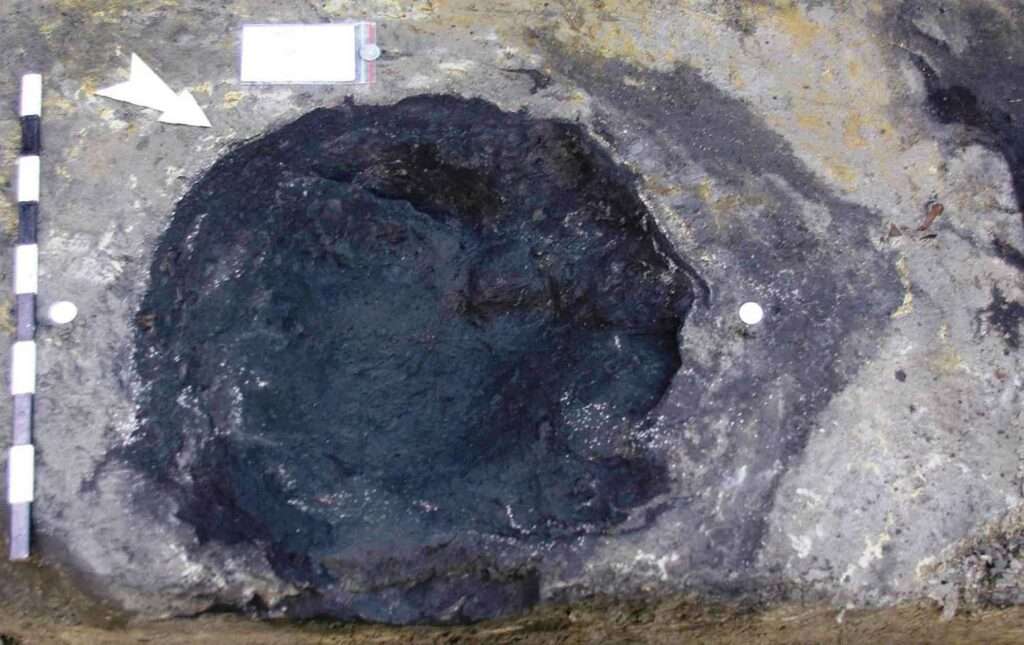Experts have discovered ancient human footprints in Germany dating back 300,000 years right next to sets of tracks left by prehistoric elephants.
The footprints, which can be seen in the footage, are believed to be the oldest in Germany and belonged to Homo heidelbergensis, an extinct subspecies of archaic humans that existed between roughly 600,000 and 200,000 years ago.
They were found in the roughly 300,000-year-old Schoeningen Palaeolithic site complex in Lower Saxony, a coal-mining area that has yielded a number of archaeological discoveries since the 1990s.
Newsflash obtained a statement from the University of Tuebingen on Thursday, 12th May, saying that “an international research team led by scientists from the University of Tuebingen and the Senckenberg Centre for Human Evolution and Palaeoenvironment presents the earliest human footprints known from Germany.”

The statement described what would have been the scene at the time the prints were made, saying: “In an open birch and pine forest with an understory of grasses sits a lake, a few kilometres long and several hundred meters wide.
“On its muddy shores, herds of elephants, rhinoceroses, and even-toed ungulates gather to drink or bathe. In the midst of this scenery stands a small family of ‘Heidelberg people’, a species of human long since extinct.”
The study’s lead author, Dr Flavio Altamura, a fellow at the Senckenberg Centre for Human Evolution and Palaeoenvironment at the University of Tuebingen (SHEP), said: “This is what it might have looked like at Schoeningen in Lower Saxony 300,000 years ago.”
He added: “For the first time, we conducted a detailed investigation of the fossil footprints from two sites in Schöningen.
“These tracks, together with information from sedimentological, archaeological, palaeontological, and palaeobotanical analyses, provide us with insights into the palaeoenvironment and the mammals that once lived in this area.
“Among the prints are three tracks that match hominin footprints – with an age of about 300,000 years, they are the oldest human tracks known from Germany and were most likely left by Homo heidelbergensis.”
The scientists have attributed two of the three human tracks that were discovered to “young individuals who used the lake and its resources in a small mixed-age group”.

Altamura said: “Depending on the season, plants, fruits, leaves, shoots, and mushrooms were available around the lake.
“Our findings confirm that the extinct human species dwelled on lake or river shores with shallow water.
“This is also known from other Lower and Middle Pleistocene sites with hominin footprints.”
The statement said: “The various tracks at Schöningen offer a snapshot of a family’s daily life and may provide information about the behaviour and social composition of hominin groups as well as spatial interactions and coexistence with elephant herds and other, smaller mammals, according to the study.”
Altamura said: “Based on the tracks, including those of children and juveniles, this was probably a family outing rather than a group of adult hunters.”
The team also analysed a series of elephant tracks “attributable to the extinct species Palaeoloxodon antiquus – an elephant with straight tusks that was the largest land animal at the time and whose adult bulls reached a body weight of up to 13 tonnes.”

Dr Jordi Serangeli, excavation supervisor at Schoeningen, said: “The elephant tracks we discovered at Schöningen reach an impressive length of 55 centimetres. In some cases, we also found wood fragments in the prints that were pushed into the – at that time still soft – soil by the animals.”
He added: “There is also one track from a rhinoceros – Stephanorhinus kirchbergensis or Stephanorhinus hemitoechus – which is the first footprint of either of these Pleistocene species ever found in Europe.”
The findings have been published in the academic journal Quaternary Science Reviews.
To find out more about the author, editor or agency that supplied this story – please click below.
Story By: Joseph Golder, Sub-Editor: Michael Leidig, Agency: Newsflash
The Ananova page is created by and dedicated to professional, independent freelance journalists. It is a place for us to showcase our work. When our news is sold to our media partners, we will include the link here.




